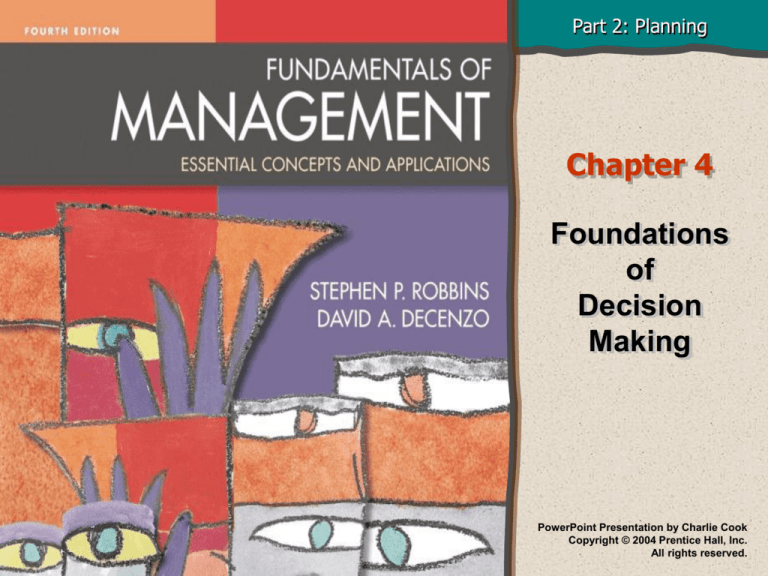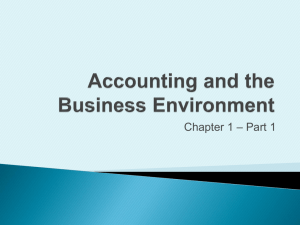
Part 2: Planning
Chapter 4
Foundations
of
Decision
Making
PowerPoint Presentation by Charlie Cook
Copyright © 2004 Prentice Hall, Inc.
All rights reserved.
LEARNING OUTCOMES
After reading this chapter, I will be able to:
1. Describe the steps in the decision-making
process.
2. Identify the assumptions of the rational
decision-making model.
3. Explain the limits to rationality.
4. Define certainty, risk, and uncertainty as they
relate to decision making.
5. Describe the actions of the bounded-rational
decision maker.
Copyright © 2004 Prentice Hall, Inc. All rights reserved.
4–2
L E A R N I N G O U T C O M E S (cont’d)
After reading this chapter, I will be able to:
6. Identify the two types of decision problems and
the two types of decisions that are used to
solve them.
7. Define heuristics and explain how they affect
the decision-making process.
8. Identify four decision-making styles.
9. Describe the advantages and disadvantages of
group decisions.
10. Explain three techniques for improving group
decision making.
Copyright © 2004 Prentice Hall, Inc. All rights reserved.
4–3
Decision-making
• Decision-making process
A set of eight steps that includes identifying a
problem, selecting a solution, and evaluating the
effectiveness of the solution
• Problem
A discrepancy between an existing and a desired
state of affairs
• Decision criteria
Factors that are relevant in a decision
Copyright © 2004 Prentice Hall, Inc. All rights reserved.
4–4
Examples of Planning-Function Decisions
What are the organization’s long-term objectives?
What strategies will best achieve those objectives?
What should the organization’s short-term objectives
be?
What is the most efficient means of completing
tasks?
What might the competition be considering?
What budgets are needed to complete department
tasks?
How difficult should individual goals be?
EXHIBIT 4.1
Copyright © 2004 Prentice Hall, Inc. All rights reserved.
4–5
The Decision-Making Process
EXHIBIT 4.2
Copyright © 2004 Prentice Hall, Inc. All rights reserved.
4–6
Criteria and Weight in Car-Buying Decision
(Scale of 1 to 10)
CRITERION
WEIGHT
Price
10
Interior comfort
8
Durability
5
Repair record
5
Performance
3
Handling
1
EXHIBIT 4.3
Copyright © 2004 Prentice Hall, Inc. All rights reserved.
4–7
Assessment of Car Alternatives
ALTERNATIVES
INITIAL INTERIOR
PRICE COMFORT
DURABILITY
REPAIR
RECORD
PERFORMANCE HANDLING
TOTAL
Jeep Cherokee
2
10
8
7
5
5
37
Ford Mustang
9
6
5
6
8
6
40
Mercedes C230
8
5
6
6
4
6
35
Pontiac Grand Am
9
5
6
7
6
5
38
Mazda Tribute
5
6
9
10
7
7
44
Dodge Durango
10
5
6
4
3
3
31
Volvo S60
4
8
7
6
8
9
42
Isuzu Axiom
7
6
8
6
5
6
38
BMW 325
9
7
6
4
4
7
37
Audi A6
5
8
5
4
10
10
42
Toyota Camry
6
5
10
10
6
6
43
Volkswagen Passat
8
6
6
5
7
8
40
EXHIBIT 4.4
Copyright © 2004 Prentice Hall, Inc. All rights reserved.
4–8
Weighting of Vehicles (Assessment Criteria X Criteria Weight)
EXHIBIT 4.5
Copyright © 2004 Prentice Hall, Inc. All rights reserved.
4–9
Decision-making (cont’d)
• Decision implementation
Putting a decision into action; includes conveying the
decision to the persons who will be affected by it and
getting their commitment to it
Copyright © 2004 Prentice Hall, Inc. All rights reserved.
4–10
Making Decisions: The Rational Model
• Certainty
The implication that the outcome of every possible
alternative is known
• Uncertainty
A condition under which there is not full knowledge of
the problem and reasonable probabilities for
alternative outcomes cannot be determined.
• Risk
The probability that a particular outcome will result
from a given decision
Copyright © 2004 Prentice Hall, Inc. All rights reserved.
4–11
Assumptions of Rationality
EXHIBIT 4.6
Copyright © 2004 Prentice Hall, Inc. All rights reserved.
4–12
Making Decisions: The Rational Model
• Rational
Describes choices that are consistent and valuemaximizing within specified constraints
• Bounded rationality
Behavior that is rational within the parameters of a
simplified model that captures the essential features
of a problem
• Satisfice
Making a “good enough” decision
Copyright © 2004 Prentice Hall, Inc. All rights reserved.
4–13
Three Elements of Creativity
Creativity
The ability to produce
novel and useful ideas
Source: T. M. Amabile, “Motivating Creativity in Organizations,” California Management Review (Fall 1997): 43.
Copyright © 2004 Prentice Hall, Inc. All rights reserved.
EXHIBIT 4.7
4–14
Common Decision-making Errors
• Heuristics: Using judgmental shortcuts
Availability heuristic
the
tendency for people to base their judgments on
information that is readily available to them
Representative heuristic
The
tendency for people to base judgments of
probability on things with which they are familiar
Escalation of commitment
An
increased commitment to a previous decision
despite negative information
Copyright © 2004 Prentice Hall, Inc. All rights reserved.
4–15
How Do Problems Differ?
• Well-structured problems
Straightforward, familiar, easily defined problems
• Ill-structured problems
New problems in which information is ambiguous or
incomplete
• Programmed decision
A repetitive decision that can be handled by a routine
approach
• Nonprogrammed decisions
Decisions that must be custom-made to solve unique and
nonrecurring problems
Copyright © 2004 Prentice Hall, Inc. All rights reserved.
4–16
Programmed Decision-Making Aids
• Policy
A general guide that establishes parameters for
making decisions about recurring problems
• Procedure
A series of interrelated sequential steps that can be
used to respond to a well-structured problem (policy
implementation)
• Rule
An explicit statement that tells managers what they
ought or ought not to do (limits on procedural actions)
Copyright © 2004 Prentice Hall, Inc. All rights reserved.
4–17
Types of Problems, Types of Decisions, and
Level in the Organization
EXHIBIT 4.8
Copyright © 2004 Prentice Hall, Inc. All rights reserved.
4–18
Technology And Decision Making
• Expert systems
Software that acts like an expert in analyzing and solving illstructured problems
Use specialized knowledge about a particular problem
area rather than general knowledge
Use qualitative reasoning rather than numerical
calculations
Perform at a level of competence higher than that of
nonexpert humans.
• Neural networks
Software that is designed to imitate the structure of brain
cells and connections among them
Copyright © 2004 Prentice Hall, Inc. All rights reserved.
4–19
Decision Making: Styles
• Directive style
Characterizes the low tolerance for ambiguity and a
rational way of thinking of individuals who are logical
and efficient and typically make fast decisions that
focus on the short term.
• Analytic style
Characterizes the high tolerance for ambiguity
combined with a rational way of thinking of individuals
who prefer to have complete information before
making a decision.
Copyright © 2004 Prentice Hall, Inc. All rights reserved.
4–20
Decision Making: Styles (cont’d)
• Conceptual style
Individuals who tend to be very broad in outlook, to
look at many alternatives, and to focus on the long
run and often look for creative solutions.
• Behavioral style
Individuals who think intuitively but have a low
tolerance for uncertainty; they work well with others,
are open to suggestions, and are concerned about
the individuals who work for them.
Copyright © 2004 Prentice Hall, Inc. All rights reserved.
4–21
Decision-Making Styles
EXHIBIT 4.9
Copyright © 2004 Prentice Hall, Inc. All rights reserved.
4–22
Group Decision Making
• Advantages
Make more accurate
decisions
Provides more complete
information
Offers a greater diversity of
experiences and
perspectives
Generates more
alternatives
Increases acceptance of a
solution
Increases the legitimacy of
a decision.
Copyright © 2004 Prentice Hall, Inc. All rights reserved.
• Disadvantages
Is more time-consuming
and less efficient
Minority domination can
influence decision process
Increased pressures to
conform to the group’s
mindset (groupthink)
Ambiguous responsibility
for the outcomes of
decisions
4–23
Improving Group Decision Making
• Brainstorming
An idea-generating process that encourages
alternatives while withholding criticism
• Nominal group technique
A decision-making technique in which group
members are physically present but operate
independently
• Electronic meeting
A type of nominal group technique in which
participants are linked by computer
Copyright © 2004 Prentice Hall, Inc. All rights reserved.
4–24
Copyright © 2004 Prentice Hall, Inc. All rights reserved.
4–25
Payoff Matrix for VISA
VISA
MARKETING
STRATEGY
S1
S2
S3
S4
AMERICAN EXPRESS’
RESPONSE
(IN MILLIONS OF $)
CA1
CA2
CA3
13
9
24
18
14
15
21
14
11
18
15
28
EXHIBIT QM–1
Copyright © 2004 Prentice Hall, Inc. All rights reserved.
4–26
Regret Matrix for VISA
VISA
MARKETING
STRATEGY
S1
S2
S3
S4
AMERICAN EXPRESS’
RESPONSE
(IN MILLIONS OF $)
CA1
CA2
CA3
11
15
0
6
7
6
0
7
17
10
13
0
EXHIBIT QM–2
Copyright © 2004 Prentice Hall, Inc. All rights reserved.
4–27
Decision Tree and Expected Values for Renting a
Large or Small Retail Space
EXHIBIT QM–3
Copyright © 2004 Prentice Hall, Inc. All rights reserved.
4–28
The
Breakeven
Analysis
EXHIBIT QM–4
Copyright © 2004 Prentice Hall, Inc. All rights reserved.
4–29
Popular Financial Controls
OBJECTIVE
RATIO
CALCULATION
Liquidity test
Current ratio
_Current assets_
Current liabilities
Acid test
Current assets level inventories
Current liabilities
Debt-to-assets
_Total debt_
Total assets
Times-interest-earned
Profits before interest and taxes
Total interest charges
Inventory turnover
Cost of sales
Inventory
Total-assets-turnover
Revenues
Total assets
Profit margin-on-revenues
Net profit after taxes
Total revenues
Return-on-investment
Net profit after taxes
Total assets
Leverage test
Operations test
Profitability
EXHIBIT QM–5
Copyright © 2004 Prentice Hall, Inc. All rights reserved.
4–30
Production Data for Virus Software
Number of Hours Required per Unit
WINDOWS
VERSION
MAC
VERSION
MONTHLY PRODUCT
CAPACITY (HOURS)
4
6
2,400
Manufacture
2.0
2.0
900
Profit per unit
$18
$24
DEPARTMENT
Design
EXHIBIT QM–6
Copyright © 2004 Prentice Hall, Inc. All rights reserved.
4–31
Graphical Solution to Hernandez’s Linear
Programming Problem
EXHIBIT QM–7
Copyright © 2004 Prentice Hall, Inc. All rights reserved.
4–32
Queuing Theory
• Queuing theory
A technique that balances the cost of having a waiting
line against the cost of service to maintain that line
Copyright © 2004 Prentice Hall, Inc. All rights reserved.
4–33
Determining the Most Economic Order
Quantity
EXHIBIT QM–8
Copyright © 2004 Prentice Hall, Inc. All rights reserved.
4–34
Economic Order Quantity
• Economic order quantity (EOQ)
A technique for balancing purchase, ordering,
carrying, and stock-out costs to derive the optimum
quantity for a purchase order
Copyright © 2004 Prentice Hall, Inc. All rights reserved.
4–35








